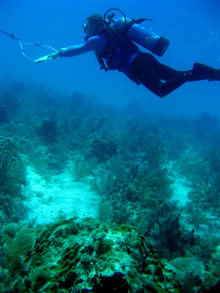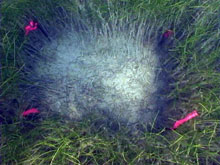For More Information
National Centers for Coastal Ocean Science
Office of National Marine Sanctuaries
Lost Lobster Traps Have Big Impact in Florida Keys

Divers towed behind a boat survey the seafloor to estimate the number and location of derelict lobster traps and trap-generated debris in regions of the Florida Keys National Marine Sanctuary.
In a new study, NOS scientists found that spiny lobster trap parts are the most common form of marine debris in the Florida Keys National Marine Sanctuary.
Surprisingly, the most heavily fished areas were not always the areas with the most trap debris.
Researchers at NOAA’s Center for Coastal Fisheries and Habitat Research used towed-diver surveys to estimate the abundance and distribution of derelict lobster traps and trap-related debris in various regions of the Sanctuary.
Florida’s commercial spiny lobster fishery—the largest commercial fishery in Florida—uses traps as the primary method of harvest.
Of the 495,000 traps currently permitted in this fishery, tens of thousands are lost annually through routine fishing practices. Trap losses are amplified during storms and hurricanes.
Derelict lobster traps are problematic because they continue to trap, injure, or kill sea life such as fish, invertebrates, sea birds, and marine mammals long after they are lost.

Researchers placed a number of lobster traps on beds of two different types of seagrass, then removed the traps at different intervals to measure the amount of damage to the grass. They found that long-term damage occurs when traps remain on top of seagrass for more than six weeks.
Traps also damage sensitive habitats and are a hazard to navigation. The loss of a trap spells lost income and economic hardship for working lobstermen, wholesalers, and the restaurant industry as well.
Researchers also measured the effect of lobster traps on seagrass, finding that the typical length of time that traps are deployed (between 7-25 days) does not result in significant damage. However, long-term injuries do occur when traps are lost and remain on top of seagrass for more than six weeks.
The findings will be used by resource managers to more effectively manage the spiny lobster fishery; and to stimulate discussion among scientists, academics, and fishery managers about fishing gear debris origins, distribution, and abundance in the wider Caribbean.
The study was a collaborative effort between NOS and the Florida Fish & Wildlife Conservation Commission.

